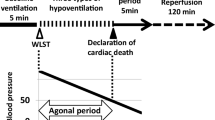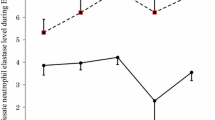Abstract
In lung transplantation, lung ischemia-reperfusion injury is a serious problem when using long-term preserved grafts. A warm ischemic lung model was prepared using rabbits. NO was administered by inhalation (group I,n=9). The control group was not administered NO (group II,n=8). Severe ischemia-reperfusion injury occurred as evidenced by hypoxia and lung edema. PaO2 at 120 min after reperfusion was 325±41 mmHg in group I and 40±6 mmHg in group II. The pulmonary blood flow of the left lung at 120 min after reperfusion was 51%±3% in group I and 20%±5% in group II. The wet-to-dry weight ratio was 5.5±0.2 for the right lungs, 5.8±0.8 for the left lung in group I, and 6.1±0.4 for the left lung in group II. Histopathologically, marked hemorrhage, hyaline membrane formation, and leukocyte infiltration were observed in group II but not in group I. These data suggested that inhaled NO reduced warm ischemia-reperfusion injury in the lung, and also contributed to a better preserved lung function.
Similar content being viewed by others
References
Novick RJ, Gehman KE, Ali IS, Lee J (1996) Lung preservation; the importance of endothelial and alveolar type II cell integrity. Ann Thorac Surg 62:302–314
Ma XL, Weyrich AS, Lefer DJ, Lefer AM (1993) Diminished basal nitric oxide release after myocardial ischemia and reperfusion promotes neutrophil adherence to coronary endothelium. Circ Res 72:403–412
Engelman DT, Watanabe M, Engelman RM, et al (1995) Constitutive nitric oxide release is impaired after ischemia and reperfusion. J Thorac Cardiovasc Surg 110:1047–1053
Pinsky DJ, Naka Y, Chowdhury NC, et al (1994) The nitric oxide/cyclic GMP pathway in organ transplantation: critical role in successful lung preservation. Proc Natl Acad Sci USA 91:12086–12090
Obo H, Yamashita C, et al (1990) The effect of PGI2 analogue on the warm ischemic changes in canine lung. Jpn J Thorac Cardiovasc Surg 38:57–65
Tobe S, Yamashita C, Nakamura K (1991) The effect of PGI2 and SOD on the reimplantation response after lung transplantation. Jpn J Thorac Cardiovasc Surg 39:20–27
Yamashita C, Obo H, Nakamura K, et al (1992) Effect of PG12 and SOD on reperfusion injury of warm ischemic lung. Ann Thorac Surg 54:921–924
Murakami S, Bacha EA, Herve P, Detruit H, Chapelier A, Dartevelle P, et al (1996) Prevention of reperfusion injury by inhaled nitric oxide in lungs harvested from non heart beating donors. Ann Thorac Surg 62:1632–1638
Macdonald P, Mundy J, Rogers P, et al (1995) Successful treatment of life-threatening acute reperfusion injury after lung transplantation with inhaled nitric oxide. J Thorac Cardiovasc Surg 110:861–863
Adatia I, Lillehei C, Arnold JH, et al (1994) Inhaled nitric oxide in the treatment of postoperative graft dysfunction after lung transplantation. Ann Thorac Surg 57:1311–1318
Cooke JP, Tsao PS (1993) Cytoprotective effect of nitric oxide. Circulation 88:2451–2454
Fullerton DA, McIntyre RC (1996) Inhaled nitric oxide: therapeutic applications in cardiothoracic surgery. Ann Thorac Surg 61:1856–1864
Naka Y, Roy DK, Smerling AJ, et al (1995) Inhaled nitric oxide fails to confer the pulmonary protection provided by distal stimulation of the nitric oxide pathway at the level of cyclic guanosine monophosphate. J Thorac Cardiovasc Surg 110:1434–1441
Freeman B (1994) Free radical chemistry of nitric oxide, looking at the dark side. Chest 344:930–933
Okada M, Yamashita C, Okada M, Okada K (1995) Contribution of endothelin-1 to warm ischemia/reperfusion injury of the rat lung. Am J Respir Crit Care Med 152:2105–2110
Benzing A, Brautigam P, Geiger K, Loop T, Beyer U, Moser E (1995) Inhaled nitric oxide reduces pulmonary transvascular albumin flux in patients with acute lung injury. Anesthesiology 83:1153–1161
Eppinger MJ, Ward PA, Jones ML, Bolling SF, Deeb GM (1995) Disparate effects of nitric oxide on lung ischemia-reperfusion injury. Ann Thorac Surg 60:1169–1176
Puybasset L, Rouby JJ, Mourgeon E, et al (1994) Inhaled nitric oxide in acute respiratory failure: dose-response curves. Intens Care Med 20:319–327
Fullerton DA, Mitchell MB, McIntyre RC, et al (1993) Cold ischemia and reperfusion each produce pulmonary vasomotor dysfunction in the transplanted lung. J Thorac Cardiovasc Surg 106:1213–1217
Author information
Authors and Affiliations
Additional information
Read at the 63rd Annual Meeting of the American College of Chest Physicians, New Orleans, LA, USA
Rights and permissions
About this article
Cite this article
Yamagishi, H., Yamashita, C. & Okada, M. Preventive influence of inhaled nitric oxide on lung ischemia-reperfusion injury. Surg Today 29, 897–901 (1999). https://doi.org/10.1007/BF02482782
Received:
Accepted:
Issue Date:
DOI: https://doi.org/10.1007/BF02482782




